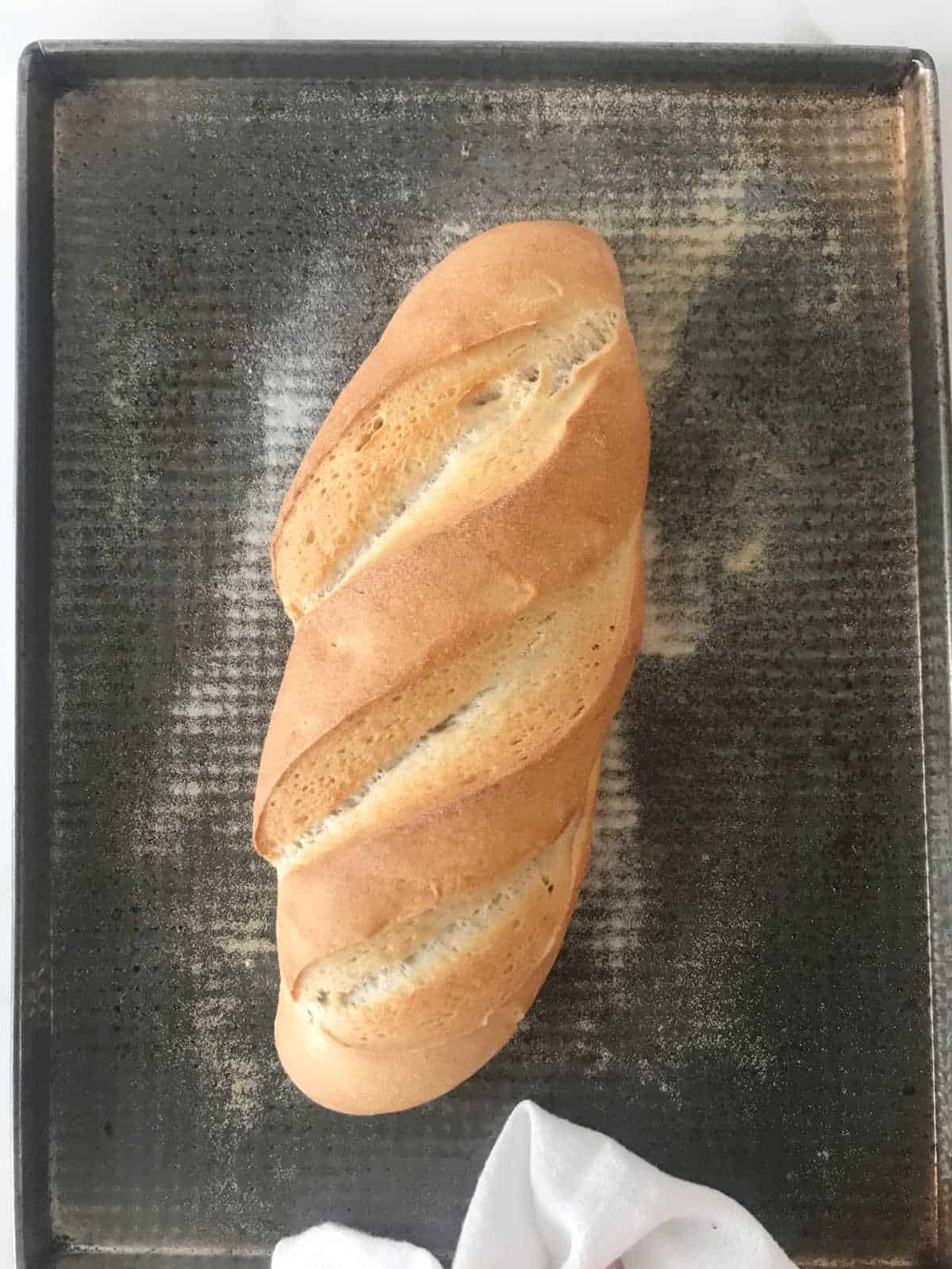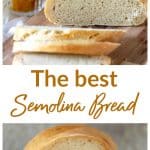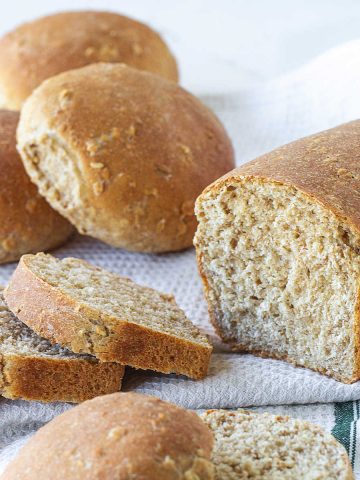This unique Italian bread is one of our star recipes and everything you want in a crusty bread. Its golden crust, creamy texture and amazing flavor make it irresistible! It's perfect for toast, bruschetta and sandwiches. If you're not an experienced yeast baker, this post has step-by-step images and instructions to guide you.

A golden loaf
I must admit this is one of my favorite breads I bake, especially for buttered breakfast toast and for sandwiches.
I love baking with yeast. And though I know it's not everybody's thing, some bread recipes are worth the time and dedication. This is one of them, for sure.
Others include oatmeal bread and 100% whole wheat bread. And let's not forget the easiest French bread, which requires no kneading and takes the complexity out of the bread-baking equation.
Semolina is a fine-textured flour made from durum wheat (used to make dried pasta). It has a nutty undertone and gives the bread a welcomed golden hue.
It's similar to very fine sand and different and much finer than bread flour.
Bread made with semolina has a crusty crust like no other.
FAQ
Semolina gives the bread a fantastic golden hue and a crusty exterior. Regular bread tends to have a lighter crumb.
This bread is a great appetizer to dip in olive oil or as part of an antipasto platter. It makes amazing toast and the best croutons, and is perfect for a quick bruschetta and some sandwiches.

Kneading Bread Dough Tips
By hand:
- Use the base of your palms for better control and pressure
- Flour: Avoid adding too much; sprinkle sparingly, knead first and adjust only if needed. Let the dough absorb added flour before adding more
- Sticky doughs: Use a dough scraper to help fold and turn doughs that are hard to handle.
With a stand mixer:
- Use the dough hook attachment.
- Start on low speed, then increase to medium once the dough comes together.
- Avoid overkneading: most bread doughs, with some exceptions like brioche, need about 5-10 minutes of kneading.
- Avoid overloading the bowl; knead large recipes in batches or smaller portions. Check the capacity of your mixer, as overloading can cause the motor to burn out.
Steps to make semolina bread
This is a fantastic recipe because it's easy to knead by hand. It is even easier with a stand mixer (using the dough hook).
It is supple, soft, and not sticky.
Make the sponge
Active-dry yeast (image 1) is mixed with flour and water (images 2 and 3). After resting covered for 1 hour it will have grown, and air pockets like bubbles will have developed (image 4). If this doesn't happen, the yeast is not working. Don't go on. Go buy new yeast.

Adding the rest of the ingredients
- With the sponge ready, we need to add the rest of the ingredients (images 5 and 6).
- It will look like there are not enough wet ingredients when you turn it out onto the counter (image 7), but the dough starts forming in no time after you start bringing it together and kneading.
- After 1 or 2 minutes, the dough is rough but not sticky, and all the ingredients are combined (image 8).

Kneading and proofing (rising) the dough
- How long does it take? About 7-8 minutes to knead it by hand and about 5 minutes with a stand mixer.
- Letting the dough rest and rise: this is a crucial part of bread making. Bread doughs with yeast need to rise until doubled in size in about 1 hour. So put it in an oiled bowl, turn it around so it's all greased, and cover the bowl with plastic (image below, left).
- Temperature: let rise in a draft-free, warm place. If the room is cold, I wrap it around something that keeps the temperature, like a sweater, blanket, or pashmina.

Forming the loaf
This part is not complicated because the dough is supple and great to work with. It can be shaped differently, and I like the batard, the French name for a plump and short baguette.
Important steps:
- Flattening the dough with your hands (image 9)
- Folding it like a cinnamon roll, and pinching after each fold (images 10 and 11)
- Pinching and sealing the whole bread (image 12) prevents it from' unfolding or unrolling' during baking.

Second rising and scoring
- Second rise: once shaped and on the baking sheet (image 13), the bread needs a second rise. Cover it loosely with a clean kitchen towel and place it in a draft-free, warm place.
- Scoring the bread: these are the cuts or slits you make to the dough right before baking it. They will allow the bread to rise better as it has a place to unfold and grow. You can use a sharp knife (images 14 to 16) or a special tool called a lame. It is a razor blade on a stick. You can lightly aid yourself with your hand (image 15), but it's best to be decisive and go for the 45° angle cut.

Baking
These loaves can have slight differences every time you bake them. If proofed correctly, the flavor will always be fantastic.
But sometimes the crust might be thinner or slightly thicker, the golden hue of the crumb might vary, and so on. Bread uses yeast and it's a living organism. So, it can be temperamental depending on the humidity, warmth of the environment, etc.
Tips to know if the bread is done:
- Size and shape: the loaf should have risen sufficiently and not appear dense. A good rise indicates that the yeast has done its job during the baking process.
- Color of the crust: the bread should be a deep golden brown.
- Hollow sound: lightly tap the bottom of the loaf with your knuckles or the back of a spoon. It should sound hollow or a spoon if it’s done. This is a traditional method that many bakers (including me) swear by, although it's less precise than using a thermometer.
- Internal temperature: some say it's the most reliable way to check if bread is fully baked. The internal temperature should be between 190°F and 210°F (88°C to 99°C).

Kitchen Notes
- Organization: read the recipe first and ensure you have ingredients at the correct temperature, utensils and equipment needed, and enough workspace. This will make the process so much easier.
- Baking time: consider that all ovens and pans are different, even if they look similar. The baking time in my recipes is as accurate as possible, but it might take you more or less time. You can use a thermometer (like the OXO oven thermometer) to check that your oven is at the right temperature. I recommend tracking how your oven works and what tiny details you might need to adjust.
- Semolina: buy the superfine one. Though it should be labeled differently, semolina comes in different textures and coarseness. Couscous, for example, is also semolina.
- Bread flour: you can buy flour that is specially made for bread. It has more gluten than all-purpose. Gluten is the ingredient that develops during kneading, creating a structure that helps the bread grow. The bread will work with all-purpose flour (but not cake flour), but it's a good idea to use the right one, and you can buy bread flour online.
- Freezing: this is a wonderful bread to freeze in slices and have ready for toast or bruschettas. Slice it and wrap it in plastic or put it in a Ziploc bag. It will last for a month.

Related recipes you might like:
Before you go
If you made this recipe and loved it, you can comment below and leave a five-star ⭐️ review. Also, if you had issues, let me know so we can troubleshoot together.
You can also subscribe to our FREE email series 'Baking the Best' and our regular newsletter. Or follow and save my recipes on Pinterest.
As an Amazon Associate, I earn from qualifying purchases. Read my disclosure policy.

Best Semolina Bread
Ingredients
Sponge:
- 1 cup lukewarm water, tap is fine
- 1 teaspoon dry yeast, use 1 teaspoon active-dry yeast or ¾ teaspoon instant yeast, see Notes below
- 1 ½ cups all-purpose or bread flour, you can buy bread flour online
Dough:
- the sponge, above
- ½ cup all-purpose or bread flour, you can buy bread flour online
- ¾ cup semolina flour
- 1 to 2 teaspoons salt, If you normally don't use much salt go for the 1 teaspoon
- 2 tablespoons olive oil
Instructions
To make the sponge:
- Place 1 cup lukewarm water in a mixing bowl and whisk in 1 teaspoon dry yeast.
- Stir in 1 ½ cups all-purpose or bread flour, mix lightly and cover the bowl with plastic wrap.
- Set the sponge aside to rise at room temperature (draft-free and warm) until the sponge doubles, about 1 hour. I do this directly in the bowl of the standing mixer and then add the dough ingredients.
To make the bread:
- Have ready a baking sheet lightly dusted with semolina.
- Stir the sponge to deflate, and add ½ cup all-purpose or bread flour, ¾ cup semolina flour, 1 to 2 teaspoons salt, and 2 tablespoons olive oil.
- Adjust the bowl in your stand mixer and knead on low speed with the dough hook for about 5 minutes to form a smooth, elastic, and slightly sticky dough. Alternatively, turn the shaggy dough onto a lightly floured surface and knead by hand for about 6-7 minutes. See the post above for images and further details.
- Transfer the dough to an oiled bowl. Turn the dough, so all the sides are oiled. Cover the bowl with plastic wrap and let rise until doubled, about 1 hour.
- Turn the risen dough out on the floured work surface.
- Press with the palms of your hands to deflate.
- Shape the dough into an oval, folding as you would a cinnamon roll, pinching at the seams after each fold, and place tucked side down on the prepared pan and cover with oiled plastic wrap.
- Allow it to rise until doubled in volume, about 1 hour.
- About 20 minutes before baking, turn the oven to 400ºF (200ºC).
- Sesame seeds on top: this is optional. Lightly dampen the dough on top (carefully, as you don't want to tear or deflate it) and sprinkle the seeds.
- Hold a razor blade or sharp kitchen knife at about a 30º to 45° angle to the loaf, and slash 3 lines.
- Bake the loaf for about 35 minutes until well risen, golden brown, and the bottom sounds hollow when tapped. All ovens are different, so if 20 minutes into baking you feel the bread is darkening too much, turn it down to 375°F (190°C) for the rest of the baking.
- Remove from oven and cool on a wire rack until able to lift from the baking sheet with a spatula, and wait until completely cooled to cut.
Notes
Adapted from How to Bake by Nick Malgieri








Jenn says
Easy recipe and comes out great every time. Thank you!
Lovena says
Best bread recipe!
Todd says
Easyvto follow. Was not happy with the end product.
It was a bit dry and too hard for my taste.
May be just my preference.
Thank you for the recipe.
Todd Edington says
The more I read through the post and comments I find I was anticipating something else.
So, it was as it should be. I made a delicious Italian Sangweech that was dense, but very tasty.
Paula Montenegro says
Hi Todd! It is a crusty bread, but it doesn't have to be too hard. You can try letting it proof a little bit more next time, especially after forming the loaf, so it's easier for it to bloom in the oven; that can render a thinner crust. It's not an exact science baking with yeast and new breads sometimes take a few tries before we get it the way we want it. Have a great weekend and happy baking.
Flo says
I followed the recipe exactly. Is this supposed to be a very dense bread?
Paula Montenegro says
Hi Flo! It should be dense but in a good way. If it’s not, it might be that it didn’t rise well or enough (old yeast, the room was too cold or it wasn’t kneaded well might be reasons for this). You can send me a picture via email and we can troubleshoot.
kerry says
Very nervous to make this recipe using cups, can you tell me the gram measurements for the flour and water please, the bread looks delicious
Paula Montenegro says
Hi Kerry, right before the ingredients list it has the options to toggle between Metric and US measures. Happy baking!
Jackie says
I made this bread almost nearly to the letter. I didn't have fine ground semolina on hand, but did have coarse ground. So I made this bread with that. It may not have had the rise I was looking for, but the taste is fantastic! It came out with a fine crumb and a good flavor. It has a very mild aftertaste of cream of wheat cereal.
Mary Ann says
I took this recipe and doubled it. The only thing I did different is I also added one cup of sourdough starter to the recipe.
instead of 2 cups of tapwater I added one cup of top water, dissolve the yeast added the rest of the ingredients to the sponge and then I added one cup of sourdough starter. It came out amazing.!!!
I also cooked them in Dutch oven 400° until they were lightly browned I wish I could add a photo!
Libby says
Excellent recipe! Worked perfectly first time try. Baked the loaf in a Fat Daddios's 7"x4" loaf pan. We wanted sandwich style toast. Kneaded with KA dough hook for ten mins adding only a smidge of bread flour so the dough completely cleared the bowl. Fabulous result baked at 400°F for first ten minutes, then 375°F for another 30 mins or so for internal temp of 206°F. Next time? Double the recipe!
Stella C says
This recipe is not your typical store bought full of air pockets bread. It’s a wonderful and dense moist bread. I used half the amount of semolina the second time I made this bread and the result was just as good. Easy to follow recipe. I’ve been making this bread now for the last few weeks. I can’t get enough of it.